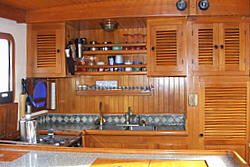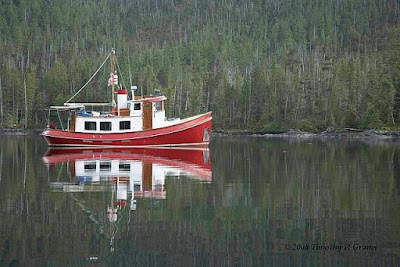37VT55 Hard Tack
| << previous tug next >> | view source print edit |

Barbara Harwick & Thomas Stracener (August 2015)
| Owner | Bought | Sold | Boat's Name | Home Port |
|---|---|---|---|---|
| Barbara Harwick & Thomas Stracener | September 2014 | Hardtack | Port Angeles, WA | |
| Dana and Tim Grams | May 2008 | September 2014 | Ecco Domani | Cordova, AK |
| Dr. Jack and Lynne Flood | 2004 | May 2008 | Ecco Domani | Bremerton, WA |
| Jeff and Dawn Mach | 2004 | Cosmos | Juneau, AK | |
| Bob Brown | F.E.W. II Many | Port Huron, MI | ||
| Frances and Susan Ward | 1987 | F.E.W. II Many | Portland, OR |
About the Owners: Past and Present
The Grams — In June 2008, the Gram's cruised Ecco Domani north to her new home in Cordova, Alaska. Read their underway updates.
The Floods — Read the story about how these former landlubbers buy the cruising dream, a sailboat and then step-up to an LNVT.
Jeff Mach —Lived in Juneau, Alaska.

Mechanical and Engine Detail
- Power: Cummins 4BT3.9M 150 hp Turbo Diesel, ~4500 hours (3/2011)
- Annual oil analysis always good, results available
- Cooling: Heat exchanger using engine coolant and raw (salt) water
- Exhaust: Wet (new wet exhaust hose 11/2011)
- Shaft: 2 inch stainless steel
- Two 12V automatic bilge pumps, backup has alarm (light and horn)
- Gusher manual bilge pump
- 12V Sure-Flow pump for fresh water in galley and head
- 12V Jabsco shower pump
- 12V macerator pump for holding tank
- Propeller: 4 Blade bronze 24"X20" (w/spare propeller on board)
- Stuffing box
- Steering: Chain cable to quadrant
- Conrols: One station Morse
- Fuel: Four aluminum tanks, ~230 gallons, 3/16" walls (New 11/2011)
- Gate valves for each tank with neoprene lines (new 11/2011)
- Four deck fill ports for fuel which allows better fuel consumption monitoring and more accurate use of biocides/fuel stabilizers. The fill port on each tank is located on the outboard edge of each tank. This allows the fill hose to be almost vertical from the deck fill port. This is a huge improvement over the original installation since it allows for much faster refueling and eliminates the "burbing" that occurs with the factory installed lines. The standard installation has about 4 feet of fill hose and vent line resting on the top of each tank which traps air and fuel in each of the lines. That residual fuel is an excellent breeding location for microbial contaminants in the fuel. The new installation eliminates the potential for fuel remaining in the lines after refueling.
- Fuel vents on the starboard tanks rise vertically above the top of the tank with no horizontal bends. The port side vents rise to just below the deck level before a horizontal bend is made. Each tank vent is on the outboard edge of the tank, next to the fill port. This is a big improvement over the original installation since it allows for much faster refueling and eliminates the "burbing" that occurs with the original installation due to the long horizontal runs in the vent lines.
- Fuel quantity in each of the tanks is measured with a Tank Tender
- Single Racor filter for initial separation of water/particulates
- Dual Racor filters with 5 micron elements for particulates/water. Vacuum gage allows monitoring of the filters to ensure partially obstructed filters can be changed in a timely manner. Dual filters allow one filter element to be changed while the engine continues to run with fuel going through the second filter.
- Water: Two 100 gallon stainless steel tanks, each measured with the Tank Tender
- Water Heater: Raritan 1700 6 gallon, heated off engine or with 110v (New 11/2011)
- Waste: 18 gallon w/Y valve, deck pump out
- Raritan manual toilet
- Propane: Two 5 gallon fiberglass tanks located in stack. Fiberglass tanks don't rust and you can see the amount of propane remaining in them.
- Air compressor: Stainless Steel tank rated at 150psi w/3 access/exit ports. One port operates horns. Second port could supply single stage regulator for underwater repairs. Third is in engine room for cleaning or winterizing water lines. Automatic cut in/cut out switch to maintain air pressure when underway.
- Horns: Kallenberg whistle & horn
- Salon/V Berth Heat: Espar diesel furnace using fuel from one of the starboard forward tank
- Salon/Pilot House: Heater Craft 5H 14,000 BTU heater using engine hot water while underway. This is the same type of heater used in a school bus.
- Bottom Paint- Petit Trinidad "hard" bottom paint. All old paint ablative bottom was removed before the Trinidad was applied (6/2011).

Electrical
- House batteries: Four 305s 6 volt batteries on the port side, wired in series and parallel yielding 12 volts with ~660 amp hours (New 10/2010)
- Starting batteries: Two group 27 12 volt batteries
- Magnum 2000 watt pure sine wave inverter/charger with remote (New 7/2010)
- Xantrek Link 20 system monitor for start and house batteries
- 30 Amp shore power with fuse/breaker protection
- Charles Industries Isolation Transformer, ISO-G2 3.6 kVA (New 8/2010)
- Stereo with 2 speakers in salon and 2 in pilot house, XM capable



Galley
- Stainless steel sink
- Main fresh water faucet supplied via on demand electric pump
- Brass hand pump for fresh water
- Refrigerator/freezer (Isotherm) top loading w/front door -very energy efficient
- Magic Chef propane 3 burner stove and oven
- Drawer below stove provides excellent access to large storage space
Electronics
- Furuno 1920 Chart Plotter (5/2008)
- Furuno DGPS 37 Global Position System Display
- Furono 525T (Airmar B45) Depth/Temperature Transducer (6/2011)
- Furuno Radar 1623 16 mile range
- Interphase iScan 180 forward scanning sonar (5/2008)
- Navigation- Ritchie compass
- Raytheon D600 depth sounder
- Datamarine wind indicator
- Simrod Autohelm AP 16 w/remote for auto pilot
- Perko Search Light
- Uniden DSC VHF radio (5/2009)
Deck
- Anchor: 65# Fulfjord w/ 225' chain backed with 250' 5/8 line
- Anchor Winch: 12v Maxwell-Nisson vertical capstan
- Spare Anchor: 25# Dansforth with 10' chain and 100' line
Other Equipment
- 2 Lewmar manual book winches on mast boom
- Ship clock & barometer
- 2 Wheelhouse defogger fans
- 1 Circulating fan in the V-Berth
- 2 Windshield wipers
- Teak Boom Pole
Safety Equipment
- Forward escape hatch
- Flare kit
- MOB sling
- Fire Equip
- Fireboay 13-1 fixed Halogen-engine room
- Kiddie watch-auto-fixed-engine room
- 2 lb. ext galley, V-berth, salon (all current)

Accomodations
- Settee converts to double berth
- Stateroom forward features double berth
- Pilothouse settee converts to single berth
- Shower: Primary across from head
- New faucet in head
Spares
- Ecco Domani is equipped for independent cruising in areas without a lot of marinas or stores so there is an extensive supply of spare parts on board. Major items include: fuel filters for the engine and Racors, engine fuel pump, engine impellor, an assortment of fuses, bulbs for interior and navigation lights, fresh water supply pump, head service kit, 12 volt bilge pump, Teflon packing for the stuffing box, various sizes and lengths of hoses, an assortment of wire and wiring supplies and other items. All spares are organized on an inventory list with on board locations and stock numbers.
- Owners manuals for all major equipment
